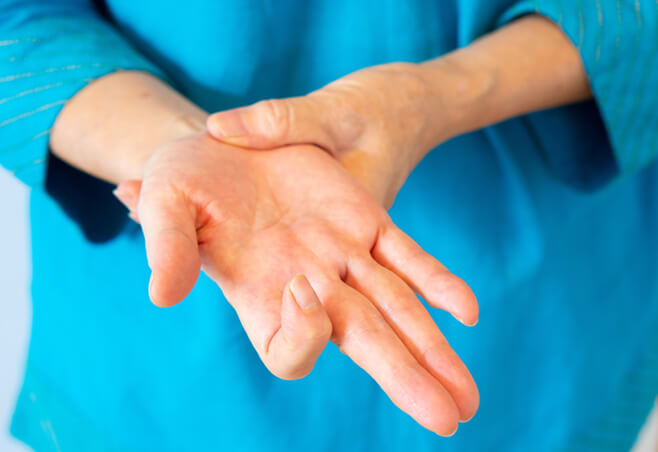Trigger finger
Trigger finger (also called trigger thumb) is a condition that causes pain, stiffness, and a locking sensation when you bend and straighten your finger. It is also known as stenosing tenosynovitis.
This condition is typically caused by vigorous hand activities that involve constantly bending the fingers. There are both surgical and nonsurgical treatments available to help relieve the symptoms. Nonsurgical treatments are the first option, but if they are not successful, then you will need to consider surgery. Surgery for trigger finger is effective, but it is not guaranteed that all movement is restored back to the effected finger.
Anatomy
When your muscles contract, the cord-like structures that attach the muscles of the forearm to the bones of the fingers, known as the flexor tendons, allow the fingers to bend.
Each of the flexor tendons pass through a tunnel in both the palm and fingers, known as the tendon sheath, that allows them to glide smoothly as the finger moves.
Along the tendon sheath, bands of tissue called “pulleys” hold the flexor tendons closely to the finger bones. The tendons pass through the pulleys as the finger moves. The pulley at the base of the finger is called the “A1 pulley.” This is the pulley that affects people most with trigger finger. Trigger finger can even cause the entire finger to become stuck in the bent position.
About
When the A1 pulley becomes inflamed, it makes it hard for the flexor tendon to glide through it as the finger bends. Over time, this can also cause the flexor tendon to become inflamed and develop a small nodule on its surface. When the finger moves and the nodule passes through the A1 pulley, there is a sensation of catching or popping that is often very painful.
Several factors can increase the chances of developing trigger finger, including:
- Forceful hand activities – Forceful uses of the fingers and thumb are the leading cause of trigger finger.
- Medical conditions – Trigger finger is most common in people with certain medical conditions, such as rheumatoid arthritis and diabetes.
The ring finger and the thumb are the two most commonly affected fingers.
Symptoms
Trigger finger symptoms will usually start without any kind of injury. But they may follow a period of heavy or extensive hand use, such as pinching or grasping activities.
There are several symptoms associated with trigger finger. These symptoms include:
- Pain when straightening or bending the finger
- A popping or locking sensation when moving the finger
- A tender lump at the base of the finger on the palm side of the hand
- Stiffness and locking that worsens after periods of inactivity
- In severe cases, the finger can be completely frozen in the bent position

Diagnosis
Your Florida Orthopaedic Institute physician will take a look at your symptoms and overall health and medical history, and then perform a physical examination. Usually, this is all that is needed to confirm your trigger finger diagnosis.
Treatment
Treatment for trigger finger usually starts off nonsurgically. Depending on the severity of your trigger finger, nonsurgical treatments may be enough to ease your symptoms. But if nonsurgical treatments are ineffective, or if your trigger finger is severe, you may need surgery. Surgery is effective but does not guarantee that all lost movement is regained. The goal of surgery is to eliminate as many of your symptoms as possible.
Nonsurgical treatments
Trigger finger treatment typically begins with nonsurgical options, such as:
- Rest – Resting your hand may be enough to heal your hand.
- Exercises – Gentle stretching can help decrease stiffness and improve range of motion in the finger.
- Medications – Anti-inflammatory pain medications like Advil and Motrin (ibuprofen) and Aleve (naproxen) can help reduce pain and swelling.
- Splinting – Wearing a splint at night will keep your finger in the straightened position, which can help relieve symptoms.
- Steroid injections – Steroids can be injected into the tendon sheath at the base of the affected finger. A steroid injection may resolve the triggering after one day or over several weeks. If symptoms do not improve with time, a second injection may be given. If two injections do not help the problem, surgery may be considered. The only downside to this option is that steroid injections are less likely to be effective in patients with diabetes.
Surgical treatments
If nonsurgical treatments are unsuccessful in treating your trigger finger, your physician will discuss surgery. During trigger finger surgery, the A1 pulley that is blocking tendon movement is released, allowing the flexor tendon to glide smoothly through the tendon sheath. The procedure is fairly speedy and is performed in an outpatient setting, meaning you can leave the Surgery Center the same day as the surgery.
Patients who have surgery experience significant improvement in function as well as relief from the pain of trigger finger. If you suffered from a loss of motion before surgery, complete range of motion might not be restored.
Videos
Related specialties
- Basal Joint Surgery
- Carpal Tunnel Syndrome
- De Quervain's Tenosynovitis
- Dislocated Finger
- Distal Radius Fracture (Broken Wrist)
- Dupuytren’s Disease
- Flexor Tendonitis
- Fractured Fingers
- Functional Nerve Transfers of the Hand
- Ganglion Cysts
- Hand & Finger Replantation
- Hand Nerve Decompression
- Hand Skin Grafts
- Nerve Pain
- Peripheral Nerve Surgery (Hand) Revision
- Revascularization of the Hand
- Rheumatoid Arthritis of the Hand
- Sports Wrist & Hand Injuries
- Sprained Wrist
- Sudden Acute Finger, Hand & Wrist Injuries
- Targeted Muscle Reinnervation (TMR)
- Tendon Transfers of the Hand
- Thumb Ulnar Collateral Ligament Injuries
- Ulnar Neuritis
- WALANT (Wide Awake Local Anesthesia No Tourniquet)
- Wrist Arthroscopy
- Wrist Fractures
- Wrist Tendonitis
